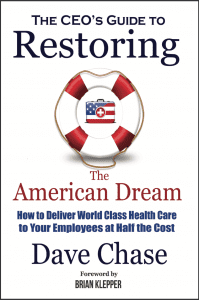You're in the Health Care Business.
Whether You Like It or Not.
Spend less and get more for you and your employees.
Improve your financial performance
It's estimated by organizations such as PwC and the Institute of Medicine that 30-50% of all health care spending is waste, fraud, or abuse. If health care is 20% of your payroll expenses, this is is like a 6-10% perpetual payroll tax on your competitiveness.
Organizations around the country, big and small, rural and urban, public sector and private, have tackled many of the sources of waste. The Health Rosetta simplifies adopting their best practices.
Here's where you can get started learning more.
The Health Rosetta is made up of specific components and strategies that enable you to repeat what others have done.
While not exhaustive, here are a few major areas likely to have the quickest and most significant impact on reducing your total spend while improving quality of care.
Components
- Major Specialties and Outlier Patients
- Transparent Pharmacy Benefits
- Transparent Medical Markets
- Transparent Independent Third Party Administrator
- Payment Integrity
Strategies
- Centers of Excellence Networks
- Reference-based Pricing
- Out-of-network Claims Settlement
- Unbundling Self-insured Health Plans
Note that all Health Rosetta components and strategies must be proven to reduce your spend, your employees' out-of-pocket spend, and improve the quality of care your employees receive.
Calculate the Impact
Reduce the out-of-pocket financial burden your employees face
Yet, more than half of Americans have less than $1,000 in savings.
Much of your workforce may be one hospital visit away from catastrophe.
As costs have gone up, employers have had to shift more costs to employees, despite spending more on payroll than ever. It's consuming 79% of all household income growth and is on track to consume 50% of all household income by 2021.
The Wall Street Journal reported that middle-class family spending on health care has increased 25% since 2007 alone.

Organizations around the country, big and small, rural and urban, public sector and private, have tackled out-of-pocket costs with far more nuanced and effective solutions than blunt force high-deductible health plans that often cause patients to forego care.
Instead, these organizations incentivize smart behavior, such as selecting high-value treatment options, clinicians, and facilities.
Here's where you can get started learning more.
The Health Rosetta is made up of specific components and strategies that enable you to repeat what others have done.
While not exhaustive, here are a few major areas likely to have the quickest and most significant impact on employee out-of-pocket spending
Components
- Value-based Primary Care
- Major Specialties and Outlier Patients
- Transparent Pharmacy Benefits
- Transparent Medical Markets
- Benefits Concierge Services
Strategies
- Reference-based Pricing
- Tiered Networks
- Centers of Excellence Networks
- Medical Tourism
Note that all Health Rosetta components and strategies must be proven to reduce your spend, your employees' out-of-pocket spend, and improve the quality of care your employees receive.
What people are saying
Dave Chase has an industry-unique ability to identify the challenges facing our health care system in a manner that the ever-expanding and frustrated masses can quickly understand. What truly distinguishes Dave’s effort is not the failures he identifies, but the thought-provoking and tested solutions he presents coupled with his willingness to challenge payers, providers and consumers alike to demand a more-rewarding health care system.
What Dave Chase has done in this long overdue book is provide a clear and extremely compelling wake up call for CEOs and CFOs to put much needed scrutiny on how, where and why they are spending significant operating budgets on healthcare for their employees—and concrete steps for how to strip out up to 30% of low-or-zero value expenditures out of this major line item.
More and more C-suite executives see health benefits a major liability, not an asset. The CEO’s Guide to Restoring the American Dream is a life saving guide to provide employees needed healthcare in way a your CFO and CEO will applaud.
The book is packed with wisdom you can’t find elsewhere but also a nice, light style that makes it addictive. There is so much in this book that is hidden behind the many layers of obfuscation characterizing our healthcare system. As a group trying to create and then disseminate new models of care that improve outcomes and lower costs, we are continuously running into hidden barriers with insurers and also un-empowered healthcare purchasers. This book has the practical prescription for moving it all forward. I’m making it required reading at Dell Med and recommending it for our many partners.
One of the top ten healthcare books of all time, and #1 for delivering practical advice.
Dave, you nailed it! Your message is vital for business leaders as it exposes the many dirty secrets behind the business of Employee Benefit plans. Yes, it is time to shed dependence on those who have benefited most from lousy results and demand vastly improved outcomes for employers and their employees. This is a must read to turn the tables on the benefits industry.
*All fields are required. You'll receive an email with the book.















